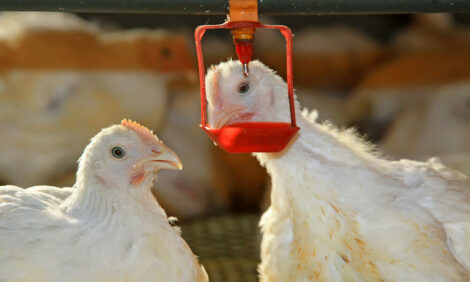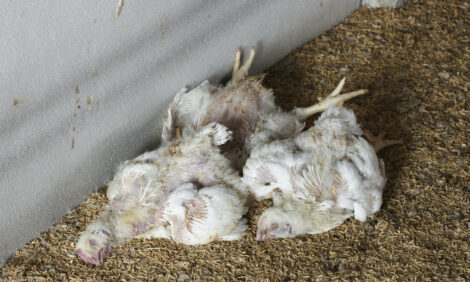



Activists Push for Arsenic Ban in Maryland
MARYLAND, US - A new report from activist group, Food & Water Watch warns of public health and environmental risks of arsenic in poultry feed and the group is calling for a ban on its use.As part of a movement to ban the use of arsenic in poultry production in Maryland, the consumer advocacy group, Food & Water Watch, has partnered with community leaders throughout the state to educate the public about the environmental and public health problems associated with the chemical.
A known poison, arsenic is often added to chicken feed in the form of the compound roxarsone to control the common intestinal disease coccidiosis, to promote growth and as a cosmetic additive, according to the report. Chronic exposure to arsenic has also been shown to increase the risk of cancer, cardiovascular disease, diabetes, neurological deficits and other health problems.
Wenonah Hauter, executive director of Food & Water Watch, commented: "The FDA approved this drug in 1944 when FDR was president. Since then, science has shown it's a dangerous, unnecessary contaminant in our food supply. Maryland has an opportunity to demonstrate true leadership on this issue by banning the use of arsenic in its poultry facilities."
The seventh largest broiler-producing state in the US, according the 2007 US Census of Agriculture, Maryland sold nearly 300 million broiler chickens that year. On the Delmarva Peninsula alone, 1,700 chicken operations raise 11 million chickens per week. Researchers estimate that between 20 and 50 metric tons of roxarsone are applied to crops there every year via poultry waste. Groundwater tests on both sides of the Chesapeake Bay's Coastal Plains found arsenic in some household wells reaching up to 13 times the Environmental Protection Agency's (EPA) tolerance limit. Arsenic in chicken litter can convert to more dangerous forms of arsenic than those originally used in feed. This is why a bill to ban arsenic in chicken feed was introduced earlier this year in the Maryland House of Delegates.
Jen Brock-Cancellieri, deputy director of the Maryland League of Conservation Voters, said: "A week ago today, Maryland's conservation-minded voters turned out in force to send a message that protecting the health of our air, land, water, and residents is an important priority. We hope that after reading this report, Maryland's legislators will continue to speak up for their constituents and support legislation to ban the unnecessary use of arsenic by the poultry industry.”
These concerns are reinforced by a new report on the poultry industry's use of arsenic also released by Food & Water Watch. Poison-Free Poultry: Why Arsenic Doesn’t Belong in Chicken Feed exposes the dangerous, widespread use of arsenic in the poultry industry and calls on Congress and the Food and Drug Administration (FDA) to take action to update antiquated rules and protect consumers.
Jenny Levin, an advocate for Maryland PIRG, said: "We should be able to eat chicken without consuming harmful additives but Marylanders are inadvertently exposing themselves and their loved ones to a known carcinogen hidden in a seemingly nutritious meal. As a proud poultry production state, Maryland should ban the use of arsenic in chicken feed immediately, thereby protecting a valuable industry and the health and trust of its citizens."
Dr Keeve Nachman, director of farming for the Future Program at the Johns Hopkins Center for a Livable Future notes that "approval of roxarsone for use in poultry and swine production is based on sorely outdated science that ignores both our present-day understanding of arsenic's toxicity and the potential for arsenic to contaminate soils, water and crops where animal waste is spread".
Although approved for use in the chicken industry by the FDA over six decades ago, the average American's annual chicken consumption has since tripled from less than 20 pounds in the 1940s to nearly 60 pounds in 2008. Yet the FDA has not revised its allowed levels for arsenic residues in poultry since 1951.
Additionally, new studies show that arsenic residues may be higher in chicken meat than previously known. USDA data suggests that the typical American is eating between 2.13 and 8.07 micrograms of total arsenic per day through consumption of chicken meat.
Ms Hauter added: "The science shows the use of arsenic in chicken feed is dangerous and that viable alternatives to arsenic exist. The FDA needs to stand up to the big chicken companies and make public health its priority."
The report outlines the shared responsibility by the FDA, USDA and EPA for fixing a fragmented, antiquated system to regulate arsenic. It concludes with recommendations to these agencies to mitigate the damage already caused by arsenic in livestock feed and calls for a ban on future use of arsenic for livestock production.
Ted Wycall, owner of Greenbranch Farm, located on the Eastern Shore, added: "One of the main reasons why we have found such strong demand for the chickens grown on our pasture is that we don't use arsenic to raise them. Consumers are smart; they don't want to eat food containing arsenic. Pasture-raised poultry is in big demand locally and nationally. Farmers should consider this a tremendous business opportunity; we need more of us doing this."
Further Reading
| - | You can view the full report from Food & Water Watch by clicking here. |









